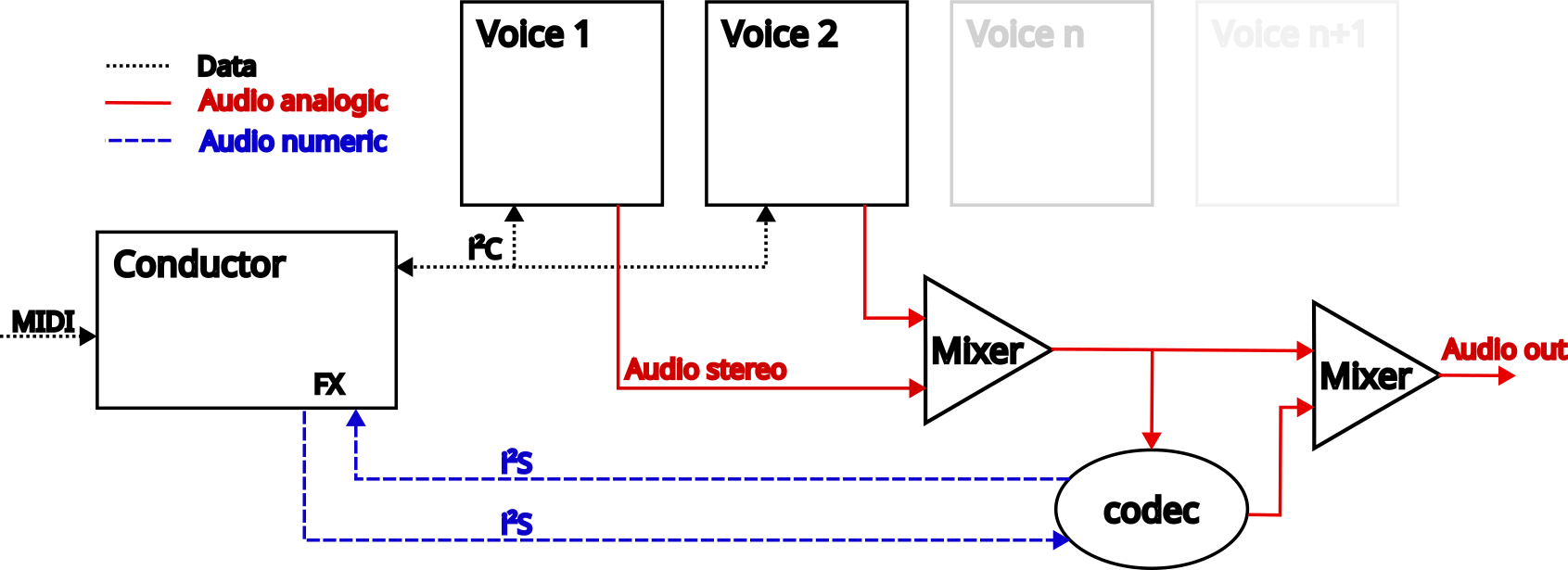The architecture of polyUAnalog centers around a simple design: a conductor board orchestrating multiple voice boards. This modular approach allows each board to function independently as a monophonic synthesizer. When combined under the guidance of the conductor board, they form a versatile polyphonic synthesizer capable of operating in various modes:
- Polyphonic Mode: Achieve polyphony with up to virtually 120 voices. Our current configuration supports 10 voices of polyphony, tested and functioning seamlessly.
- Monophonic with Unison and Spread Mode: For those moments when a single, powerful voice is needed, enhanced with unison and spread capabilities for added depth.
- Multi-timbral Mode (Under development as of April 2024): Expanding the synth's versatility by allowing multiple timbres to be played simultaneously.
The polyUAnalog repository is organized into two main directories, firmware and hardware, each containing subdirectories dedicated to different components of the synth:
Contains all necessary code to bring the polyUAnalog to life. This includes the microcontroller programming for voice and conductor boards, as well as the controller interface.
- Voice Board: The soul of the polyUAnalog's sound, each voice board is an independent monophonic synthesizer.
- Conductor Board: The brain behind the operation, orchestrating the voice boards to work in harmony.
- Controller: Interface and panel design for hands-on control of the polyUAnalog.
Detailed schematics, PCB designs, and everything required to physically construct the polyUAnalog synth.
- Voice Board: Designs and instructions to build each monophonic voice board.
- Conductor Board: The blueprint for constructing the central conductor board.
- Controller: Panel design and schematics for the physical user interface.
For specific details on each component, please refer to the corresponding README.md file within its directory. Our aim is to make the assembly and understanding of the polyUAnalog as accessible as possible.
polyUAnalog thrives on community input and collaboration. Whether you're a seasoned electrical engineer, a software developer with a knack for DSP, or an enthusiast eager to learn and explore, your contributions are welcome.
We have documented our journey and findings in a comprehensive academic paper. This paper delves into the theoretical underpinnings, design choices, and technical challenges encountered during the development of polyUAnalog. While the paper is currently in draft form and distributed as-is, we believe it provides valuable insights into the project's scientific and engineering aspects.
A DOI and access to the official publication will be provided upon acceptance. Additionally, a pre-print version of the paper will be made available to ensure our findings are accessible to the community, fostering further research and development in the field of analog synthesis.
We are currently compiling a diverse range of audio samples to showcase the versatility and musicality of polyUAnalog. This is a work in progress, and we appreciate your patience as we curate a collection that truly represents the essence of this project.
Stay tuned for a SoundCloud link, which will be shared here soon.
polyUAnalog is open source and distributed under the MIT License.
